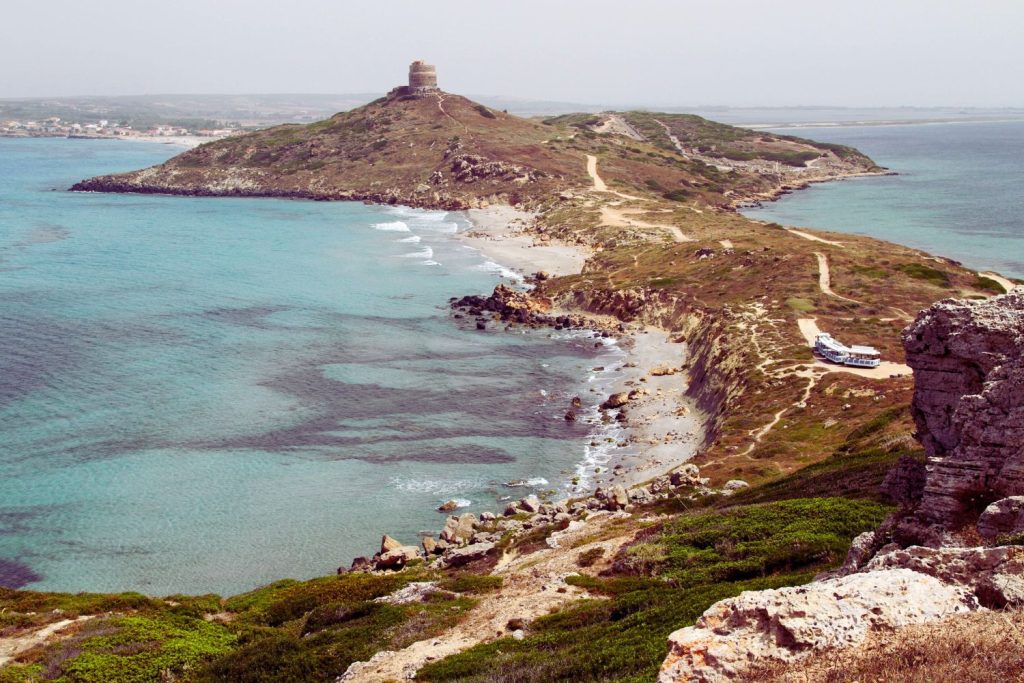At the center of the western coast of Sardinia is Cabras, a city of ancient origins rich in landscape and archaeological wonders that will delight tourists from all over the world.
Cabras is the beating heart of the Sinis peninsula, wild and unspoilt, whose colors are typical of nature. Its landscape is varied, characterized by beautiful beaches alternating with marshy areas, and its culinary tradition manages to leave anyone speechless. At the end of the day, in fact, you should enjoy an excellent dinner in one of the typical restaurants of Cabras and maybe delight yourself with the mullet bottarga produced here, a sublime specialty.
The beaches of Cabras
The coast of Cabras is rich in sandy beaches bathed by an extraordinarily turquoise sea. Among the most beautiful is Is Arutas, a beach composed of fine grains of colored quartz with waters that go from green to blue. The seabed goes down quickly, so that a short distance from the shore you can admire a very rich marine fauna. Is Arutas is, in practice, the ideal place for those who love snorkeling, kitesurfing and windsurfing.
Heading north, however, you can stop at Mari Ermi, an enchanting beach of golden sand mixed with white and pink quartz, and Portu S’Uedda, a beach composed of sand and rocks. Finally, those who have the opportunity to move a few kilometers, can discover the beautiful beaches of the Costa Verde, in particular Torre dei Corsari and Pistis Beach.
The archaeological area of Tharros
A must-visit during a stay in Cabras is the archaeological site of Tharros. The homonymous city was founded by the Phoenicians in the eighth century BC, conquered by Carthaginians, Romans and Byzantines and finally transformed into the current city of Oristano.
Today, it consists of a real open-air museum in the form of a natural amphitheater that, inside, houses millennial remains of temples, nuraghes, spas, cemeteries and tophet.
San Salvatore di Sinis
Going from the center of Cabras to the beach of Is Arutas you will come across the village of San Salvatore di Sinis, a small town with low houses and temporary religious center, which comes alive during local festivals. The most interesting building is the small Church of San Salvatore, built on the remains of a previous early Christian church.

Foto : Expedia
The Civic Museum Giovanni Marongiu
Custodian of the millennial history of the Sinis Peninsula, home of the Giants of Mont’e Prama, the Civic Museum Giovanni Marongiu of Cabras was inaugurated in 1997 and dedicated to the eminent local personality.
The exhibits inside document a settlement from the Neolithic to the time of Imperial Rome, including grave goods, green and obsidian stone objects, cultural facies and decorated ceramics.
Since 2014, the museum has been enriched with two windows entirely dedicated to the nuragic village of sa Osa and a room that houses the statues of the Giants, reassembled following the discovery of finds in the necropolis of Mont’e Prama dating back to the Iron Age.
On the occasion of the excavations, carried out from 1975 to 1979, more than 40 burials and more than 5 thousand fragments were found, subsequently reassembled to give life to 30 mighty sculptures almost 2 meters high: 18 naked-chested Pugilators, equipped with skirts, glove and shield, 6 archers with tunic, helmet and bow and 6 warriors.
Mont’e Prama was the sacred and funerary area reserved for the dominant clan and extended on the border between the Nuragic territory and the settlement of the Phoenicians, settled precisely where the city of Tharros then arose.
The Phoenician testimonies correspond to the materials of the tophet, the outdoor funerary sanctuary built on the pre-existing nuragic village of su Murru Mannu. A part of the tophet room is dedicated to the artisan district, which dealt with the processing of bronze, ceramics and iron.
The Punic necropolis, however, were two: one at the village of San Giovanni di Sinis, the other at Capo San Marco. And it is from here that many finds of amulets, ceramics, metal artifacts and jewelry derive.
The last room of the museum is, instead, focused on a great underwater discovery dating back to 1989: among the remains of the hull of a Roman ship, a little more than a mile from the island of Mal di Ventre, was found a load of 1000 ingots of lead, each weighing 33 kilos and half a meter long, which allows us to date the wreck between 89 and 50 B.C.
In addition, the museum also hosts temporary exhibitions, conferences and educational workshops. Once inside, you can get involved by the beauty of the beaches of the protected marine area of Sinis, discover the vegetation and animals that populate it, the history and the thousand-year tradition.
After the visit, the ideal is to stop at a local restaurant and order a typical dish accompanied by an excellent bottle of wine, categorically with sea view, just to end the day in beauty and breathe the pure and exciting air that you can find only in Sardinia.
Copertina: Expedia




